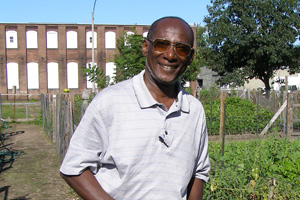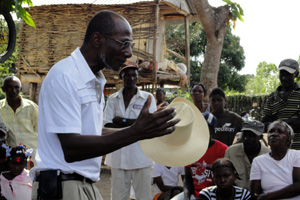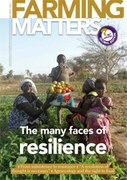Cantave Jean-Baptiste is a Haitian agronomist and rural development practitioner with more than three decades of experience supporting sustainable agriculture and strengthening peasant organisations. He is Executive Director of Partenariat pour le Développement Local (PDL) in Haiti, and a founding member of Groundswell International. Farming Matters asked Mr Jean-Baptiste how family farmers can build resilience in Haiti, a country where an estimated 80% of the population lives in poverty.

Why are Haitians so vulnerable to natural disasters?
“Farmers see that diversification increases biodiversity while providing food throughout the year”
The 2010 earthquake killed hundreds of thousands of people in Port-au-Prince, Leogane, Petit Goave, Jacmel and surrounding areas, and also left very many people injured. It destroyed key infrastructure and many of the devastated sites are still in ruins four years later. Moreover, families around the country spent the little money they had providing support to their relatives in the cities, resulting in a drain of resources and more poverty in rural areas.
Many millions of dollars in development aid were spent on immediate assistance, but much less on longer term recovery, and especially on increasing resilience. Well before the earthquake, however, the country had been experiencing frequent disasters such as droughts and hurricanes. These forced people to migrate to the cities, which created new concentrations of misery there.
Rural areas, and much needed sustainable agricultural approaches such as agroecology, are neglected by central government. Family farming remains the main economic activity for Haiti, yet it receives little attention or support. Existing irrigation systems are poorly managed and maintained and access to inputs is limited. Tonnes of fruit are also wasted in isolated rural areas because of the lack of facilities and capacity to process them and poor transport infrastructure.
How can rural communities build resilience and overcome poverty?
More than 200 years after independence, Haiti’s rural areas still bear the scars of colonisation: marginalisation, mistrust, exploitation and injustice. My 35 years’ experience has taught me that a revolution of thought is necessary to reshape the mentality of rural people and build a common vision among family farmers to create a better future.
People need to refuse to be marginalised and to overcome it – to consider themselves as citizens and human beings. People need to understand that poverty is mostly man-made rather than something that is determined by fate. I know that this is not easy to achieve. It requires time, a clear vision, and a strong determination to face adversity and stand up to the dominant trends working against rural communities.
How do you strengthen peasant organisations?

Partenariat pour le Développement Local organises sessions at the community level that promote reflection, build confidence, and build their capacity to mobilise and use their own assets to overcome common challenges. Putting into practice our national motto ‘Union Makes Strength’, we help identify community problems that one family is not able resolve alone, and help them to pool their resources and energy to deal with it. This convinces rural people of their own potential. They first form small groups of 15-20 people which we call gwoupman. The gwoupman set up a village level organisational structure to take charge of the community development process. Then several villages unite and structure themselves into a local peasant organisation.
The collective leadership leads activities and connects to partners who can provide different kinds of support. Local peasant organisations participate in the design and implementation of their own programmes while we are still playing a support role, and take full charge of managing their own activities when they reach a certain level of autonomy. We have found that this is the best way to build community capacity and guarantee the resilience and sustainability of rural development processes.
How have you been promoting agroecological practices?
Promoting agroecological practices starts with on-farm experimentation, controlling soil erosion using stone and living contour barriers, and improving soil fertility through better use of organic matter.
Our technicians visit farmers in their fields and work with them to identify the constraints they are facing. Most of the time, the farmers’ main challenges are poor soil fertility, low seed quality, crop pests, and limited access to basic tools and inputs. Then, we talk with farmers and support their experiments such as carefully selecting the seeds they save, or mixing different crops on their plots to improve ground cover and to extend the harvest period.
Farmers see that diversification increases biodiversity while providing food throughout the year. Integrating fruit and forest trees in farming systems also helps to secure long term protection and resilience.
What were the factors behind the success of your approach?
Key factors of success include the need to have successful farmers who are open to experiment, adopt new practices and train their neighbours. It is also important that farmer organisations set up seed banks with part of their harvest to secure seeds for the coming rainy season, and that they lend out seeds which are paid back in kind and with interest in order to be able to respond to more and more participants’ needs over time. A good start helps, and often the first year’s results convince farmers to work on mastering the new practices and then to start teaching others. Finally, local organisational structures must develop the capacity to manage community programmes themselves to ensure long term sustainability.
What more is needed?
We should not limit our actions to only promoting better food systems. We should envision the total well being of farming families. We need to develop different kinds of livelihoods aimed at increasing family and community revenue. We should promote local savings and community managed microfinance to facilitate cash circulation and protect poor families against the vicious cycle of debt entrapment. Improved sanitation, basic hygiene and education allows for better quality of life and limiting epidemics such as cholera that were introduced into Haiti after the earthquake. And finally, rural communities can be wealthier and healthier when local organisational structures are strong, and to achieve that, we need enlightened community leadership.
What do you expect from this International Year of Family Farming?
I wonder how many organisations in Haiti even know about this International Year of Family Farming! We are already in the fifth month of the year, and promoters could make more efforts in outreach and communication. I do hope, however, that the voice of family farmers echoes widely and reaches the ears and consciousness of decision makers in the South and the North.
Interview: Steve Brescia

